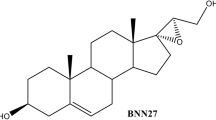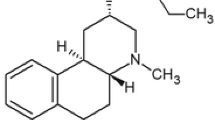Abstract
This study examined the effect of the neuroactive steroid 3α, 5α-tetrahydrodeoxycorticosterone (α-THDOC) as compared to the benzodiazepines diazepam and midazolam and the barbiturate phenobarbital on the number of rearing events and the number of steps ascended in the mouse staircase test. The benzodiazepines, phenobarbital and α-THDOC all reduced rearing activity at doses that did not affect climbing. The rearing-suppression effect of the benzodiazepines and α-THDOC, but not of phenobarbital, was blocked by the benzodiazepine antagonist flumazenil. It appears that, although such neuroactive steroids, like barbiturates, bind to distinct sites within the chloride ion channel of the gamma-aminobutyric acid type A (GABAA) receptor complex, α-THDOC behavioral activity is modulated by the benzodiazepine recognition site.
Similar content being viewed by others
Author information
Authors and Affiliations
Additional information
Received: 19 October 1995 / Final version: 1 July 1996
Rights and permissions
About this article
Cite this article
Pick, C., Peter, Y., Terkel, J. et al. Effect of the neuroactive steroid α-THDOC on staircase test behavior in mice. Psychopharmacology 128, 61–66 (1996). https://doi.org/10.1007/s002130050110
Issue Date:
DOI: https://doi.org/10.1007/s002130050110




